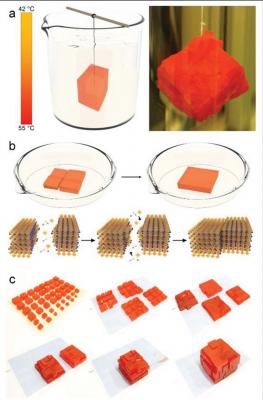Researchers at Ecole Polytechnique Fédérale de Lausanne (EPFL), assisted by teams at Croatia's University of Split, have developed a perovskite that can detect gamma rays.
 The 'oriented crystal'crystal growth' (OC2G) method of large MAPbBr3 crystals . a) Growing of large crystals by the suspended seed crystal; b,c) The consecutive steps of fusing together individual single crystals into a large crystal. Image by EPFL
The 'oriented crystal'crystal growth' (OC2G) method of large MAPbBr3 crystals . a) Growing of large crystals by the suspended seed crystal; b,c) The consecutive steps of fusing together individual single crystals into a large crystal. Image by EPFL
"This photovoltaic perovskite crystal, grown in this kilogram size, is a game changer," says EPFL's Professors Lászlo Forró. "You can slice it into wafers, like silicon, for optoelectronic applications, and, in this paper, we demonstrate its utility in gamma-ray detection."
However, exactly because gamma rays can affect biological tissue, it is vital to keep an eye on them. To do this, simple, reliable, and cheap gamma-ray detectors are required. The perovskite that the EPFL scientists developed is based on crystals of methylammonium lead tribromide (MAPbBr3) and seems to be an ideal candidate, meeting all these requirements.
Perovskites are first "grown" as crystals, and the quality and clarity of the crystals determines the efficiency of the material when it is turned into thin films that can be used in devices like solar panels.
The perovskite crystals that the EPFL scientists made show high clarity with very low impurities. When they tested gamma-rays on the crystals, they found that they generated photo-carriers with a high "mobility-lifetime product", which is a measurement of the quality of radiation detectors. In short, the perovskite can efficiently detect gamma rays at room temperatures, simply by resistivity measurement.
The MAPbBr3 part of the "metal halide" family of perovskites, meaning that, unlike market-leading crystals, its crystals can be grown from abundant and low-cost raw materials. The synthesis takes place in solutions close to room temperature without needing expensive equipment.
Of course, this is not the first perovskite made for gamma ray-detection. But the volume of most lab-grown metal halide perovskites used for this is limited to about 1.2 ml, which is hardly scalable to commercial levels. However, the team at EPFL also developed a unique method called 'oriented crystal-crystal intergrowth' that allowed them to make a whole liter of crystals weighing 3.8 kg in total.
Just a few days prior to the release of this work, Northwestern University researchers announced the development of new perovskite-based devices to assist in the detection and identification of radioactive isotopes. This method could allow the identification of legal versus illegal gamma rays - such detectors are critical for national security, where they're used to detect illegal nuclear materials smuggled across borders and aid in nuclear forensics, as well as in medical diagnostics imaging.



